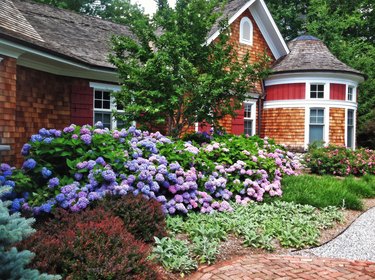
Gardeners living in USDA zone 9 have several hydrangea varieties that will perform well in their gardens, filling the area with their showy blooms. Oakleaf hydrangea (Hydrangea quercifolia, U.S. Department of Agriculture plant hardiness zones 5 to 9) and bigleaf hydrangea (Hydrangea macrophylla, USDA zones 5 to 11) both grow well in the zone provided that their growing preferences are satisfied.
Characteristics of Bigleaf Hydrangeas
Video of the Day
Also commonly called mopheads due to their large, ball-like flower clusters, bigleaf hydrangeas are definite showstoppers in the garden when in bloom. The deciduous shrub has a rounded habit and typically averages anywhere from 3 to 6 feet tall and wide at maturity. Depending on the cultivar, the serrated foliage is dark green to yellowish and grows 3 to 6 inches long and wide.
Video of the Day
In summer, bigleaf hydrangeas burst into bloom and depending on the cultivar produces either clusters of round, ball-like blooms or more flattened blooms called lacecaps. Affected by the soil's pH, flower colors include hues of pink, blue, white, or purple. Acidic soils with a pH of 5.0 to 5.5 produce blue blooms, and soils more alkaline with a pH of 6.0 to 6.5 produce pinker blooms. You can change the color of the blooms by acidifying the soil by incorporating aluminum sulfate, and you can make it more alkaline by incorporating lime, working it about 4 to 6 inches into the soil. Plants bloom on old wood.
Characteristics of Oakleaf Hydrangea
Native to the Southeastern United States, oakleaf hydrangea earns its common name due to the foliage resembling oak leaves. The deciduous shrub grows 6 to 8 feet tall and wide but usually averages around 4 to 6 feet. Foliage is dark green throughout the growing season, changing to colors of bronze, red, and purple in fall and can remain attached long into winter, adding color to a winter landscape. The large leaves can grow up to a foot long with a similar width. The peeling bark adds additional interest.
In summer, large, white, cone-shaped blooms appear in clusters with the flowers eventually changing to purple or light pink. The flowers remain on the shrub for months. Unlike bigleaf hydrangea varieties, oakleaf flowers are unaffected by changes in the soil's pH. Plants bloom on old wood.
The Oakleaf hydrangea works well in locations in the landscape that can use a bit of winter color. It also makes an attractive addition when used as a foundation planting, accent, or specimen. The hydrangea is useful as an informal hedge, when used in mass plantings, or as an understory plant in woodland gardens.
Considerations for Good Growth
Bigleaf and oakleaf hydrangeas grow well in fertile soils that drain well and are kept moist but not soggy through regular water applications, which might be several times weekly depending on your local conditions. Both types grow well in full to partial shade but will also grow well with a few hours of full sun if soil conditions are kept moist. However, oakleaf hydrangeas do best when grown in a shadier environment in zone 9 and tolerate a sunnier environment in cooler portions of its hardiness zones. Applying a several-inch layer of organic mulch helps conserve soil moisture and cuts down on unwanted weed growth.
Flowers develop on old wood, so do any desired pruning, shaping, or removing of damaged or dead wood immediately after both types of hydrangeas stop flowering. The hydrangeas might not bloom if trimmed too late in the season and close to bud development. If you desire to change the pH of the soil to change flower color, be sure to start the treatments early in the season, like late fall or early spring. It might take several blooming cycles to see the blooms change color.
All portions of the hydrangea are mildly toxic to both humans and pets, containing hydrangin, which is a cyanogenic glycoside. If ingested, the plant can cause stomach issues, like nausea, vomiting, and stomach pain, as well as sweating. Keep children and pets away from hydrangeas and call poison control if you suspect your child or pet has ingested a portion.